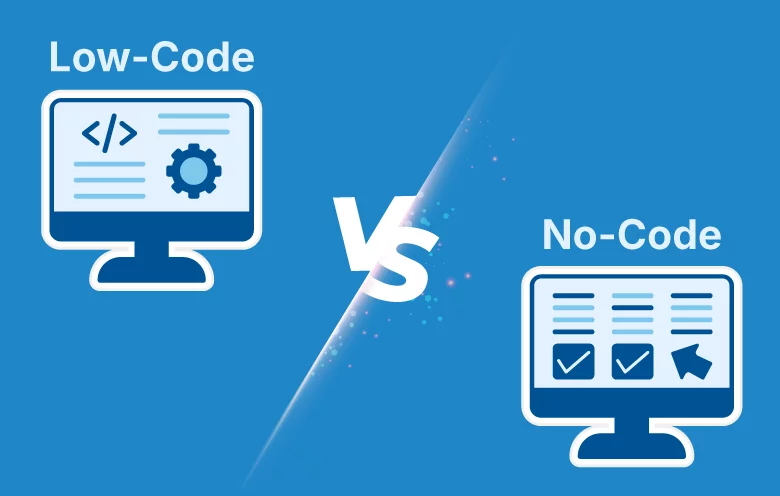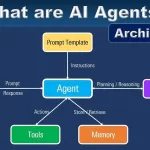Say Goodbye to coding – with Low Code and No Code#
Have you ever wished you could develop your own software solutions with just a few clicks, without having to write line after line of code? Imagine how easy and fast software development would suddenly be for you! Does it feel like science fiction? But it’s not: Take a look at the world of low-code development with us! In the following article, we also look at the difference between low code and no code and clarify what a no-code/low-code platform is.
What is low code?#
Low code is the technical term for development methods in which programming is no longer carried out using text-based programming languages, but on the basis of visual aids. Intuitive graphical tools and ready-made modules make it possible to create applications with little manual programming effort.
What is a low code platform?#
A low-code platform is a development environment in which you can create software applications largely without text-based programming. Instead of writing hundreds of lines of code, you work with a visual user interface on which you can assemble prefabricated building blocks in a modular way. These building blocks represent specific functions or logic that you would normally have to implement using conventional programming.
5 main features of low code platforms#
The core features of a low-code platform can be summarized using these characteristics:
- Visual development environment: Instead of writing complex code line by line, you use a graphical user interface where you can simply drag and drop pre-built components together.
- Reusable building blocks: Low code platforms offer a variety of pre-built elements, modules and templates that you can combine, reuse and customize to your needs over and over again.
- Manual code integration: Although the focus is on visual development, many low code platforms also allow you to integrate your own scripts. This gives you the opportunity to implement custom functions that go beyond the standard options.
- Rapid deployment: Lowcode allows you to develop and deploy software prototypes and working applications in a very short time, which is especially beneficial in agile development environments.
- Cloud-based use: In most cases, software applications are developed, deployed and used conveniently via a web browser. However, some low-code platforms can not only be used in the cloud, but can also be installed locally as an on-premises system.
What is No Code?#
No Code goes one step further: unlike low-code platforms, a no-code platform is aimed at users without any programming knowledge. In the fully visual development environment, you can create applications mostly by drag-and-drop without having to write a single line of code. No Code is therefore ideal for creating simple applications and automated workflows . The focus here is clearly on speed and user-friendliness; the integration of self-written code is not provided for.
Low code vs. no code#
However, the transitions between the two approaches are fluid. For this reason, many tools cannot be clearly assigned to the no code or low code area. The main difference between low code / no code lies in the target group, the flexibility and the complexity of the applications.
Target group: A low code platform is aimed at developers who want to enjoy fast, modular development but still want the option of implementing user-defined functions through manual programming. No Code, on the other hand, is mainly aimed at users with no prior technical knowledge.
Flexibility: A low-code platform offers more flexibility and customization options, as developers can intervene in the code and program their own components if required. No-code platforms are designed more for standard solutions and offer less scope for individual customization, as they specify a large part of the design.
Complexity of applications: Low-code allows you to create more complex applications that can be extended at will, while no-code is more suitable for simple, off-the-shelf solutions.
Areas of application for low-code development#
Both development methods are particularly suitable for companies that have limited developer capacities, need to react quickly to changes and are looking for an efficient way to develop customized software solutions. No code and low code are not limited to one industry or specific processes, but can be used almost universally.
Typical use cases are
- Process automation: Automate workflows and processes to increase efficiency in your company.
- Customizable off-the-shelf solutions: Drive off-the-shelf development of standard solutions that can be customized to meet the business needs of different customers or departments.
- Citizen Development: Turn today’s users into tomorrow’s developers with the help of no-code. This relieves your IT department, which can instead take on steering and strategic tasks.
- Prototypes and MVPs (Minimum Viable Products): Quickly develop ready-to-use software prototypes to test ideas and get early feedback.
Should you use a low-code or no-code platform?#
The choice between low code and no code depends on your specific requirements:
- If you need a quick solution for a digital process and the application does not have highly customized requirements, a no code platform should suffice.
- However, if you need a complex, customized application that you want to develop yourself over time, a low-code platform is the better choice.
Is low-code development the future?#
In the digital era, low-code platforms are becoming increasingly important. This is because their technologies make it possible to develop software applications faster, more efficiently and with less technical expertise. Compared to traditional programming, low-code development requires only a fraction of the time to deliver the software.
Due to this unbeatable efficiency and cost savings, low-code platforms are naturally of interest to many companies and play a key role in the ongoing digitalization of business processes. It can be assumed that almost all companies and people who work with computers have a need for this type of development and problem solving.
does low-code development belong to the future?(Gehoert-der-Low-Code-Entwicklung-die-Zukunft.jpg)
At the same time, the high level of customer interest means that more and more low-code solutions are entering the market. No wonder that market analyses by Gartner show how almost 14 billion US dollars were already generated with low-code development technologies in 2021. Furthermore, Gartner assumes that by 2024, two thirds of all software developments will be attributable to low-code platforms.
Comparison of types of no-code/low-code platforms#
Most low-code providers can be summarized in four large groups. Unsurprisingly, the demand for low-code platforms is highest exactly where almost every company needs software: for websites, apps, databases and automated processes.
Website builder#
Gone are the days when you had to hire an expensive agency or web designer for a fancy website. With these low-code platforms, you can design simple websites without much programming knowledge: WordPress, Webflow, Wix, Squarespace, Framer, Dorik and many more. Some website builders such as Shopify, Sharetribe, BigCommerce or WooCommerce specialize in online stores.
App builder#
Software solutions in this category help you to create complete web applications and native apps for desktops or mobile devices. External data sources such as spreadsheets or databases are often tapped into. Low code providers in this area include Glide, AppSheet, Softr, Draftbit, Adalo and Zoho Creator.
Databases#
In every digital process, you need to capture or process data in some form. That’s why there are database-based low-code platforms that help you store and visualize your data in a structured way. The best-known providers include SeaTable, Airtable, Baserow and NoCoDB.
Automation platforms#
Automation platforms such as Zapier, make or n8n are used to exchange data between two or more applications. The logic of these solutions is always the same: First you define a trigger, i.e. an event, which then triggers your automations under certain conditions. This allows you to run even complex processes fully automatically.
In addition to these four categories, there are also more niche low-code platforms such as chatbot builders. In addition, a solution cannot always be assigned to just one category, as we will see in the following example.
SeaTable: No-code database with integrated app builder, scripts and automations#
In SeaTable, you can configure processes and applications conveniently via a graphical user interface in the browser. Thanks to the visual elements, you do not need a single line of code, which makes SeaTable a no-code solution . However, SeaTable also allows the execution of manually programmed JavaScript and Python scripts. This option is more in line with the low-coding approach, which means that SeaTable could also be described as a low-code development platform.
The classification into a category is also not clear: On the one hand, SeaTable is a no-code database in which you can store, organize and visualize almost any type of information. You can use 25 different column types, plugins such as gallery, Kanban, map or calendar, views with filter, sorting and grouping functions as well as statistics and web forms.
SeaTable also offers a No Code App Builder, which you can use to build your own apps without any programming knowledge. An app accesses the information in the database backend and displays it optimally for the end user. For the app design, there are ready-made page types with visual elements that you can simply drag and drop together.
What is the difference between no-code and low-code development?
What characterizes no-code development?
Since no-code platforms are designed for users with little or no programming experience, they are designed to simplify the application creation process. These features allow users to efficiently turn their ideas into working software by applying their institutional knowledge and experience to create effective solutions. Some of the most basic no-code features include:
- Drag-and-Drop Interface
Traditionally, creating a software application was like writing a highly specialized instruction book: programmers wrote lines of code that told the software how to respond to specific input. For this task, software developers needed an in-depth knowledge of each coding language. Modern drag-and-drop coding tools eliminate this need for knowledge. Using drag and drop, users can develop applications visually , selecting and assembling elements and placing them within a graphical representation of the application design. This approach eliminates manual coding and instead offers an intuitive interface that allows any user to design custom applications. - Data Connections
No application works in isolation, at least not if you want it to work effectively with external data sources. Data connections are the bridges that allow your code-free application to interact with various databases, APIs, or external services. This feature allows users to pull data from various sources, such as Excel spreadsheets, SQL databases, or even third-party services. Users can define these connections through a simple, code-free configuration process, again avoiding the need for manual coding. - User Interface Builder and Visual Modeling
The User Interface Builder and visual modeling features provide a high-level overview of the application’s structure and appearance. Instead of coding the user interface from scratch, users can assemble preconfigured components. These components are pre-assigned with scripts, so the user only needs to select and organize them. These tools allow organizations to apply features to their applications that would otherwise be difficult to include without extensive software development experience.
What are the advantages of no-code development?
No-code development offers businesses several advantages over manual coding.
Better understanding of the business
The no-code approach enables stakeholders who best understand the business, business processes, and user experience requirements to create applications that best meet those needs. This improves application functionality and delivers an optimized user experience.
Automate business processes
Traditional coding involves many manual tasks. However, with no-code development, these basic, time-consuming responsibilities are streamlined. This not only promotes faster development and increased productivity, but also improves process visibility and traceability.
Accelerate application development
No-code development significantly reduces the time spent creating new applications. By automating key processes and providing complete modular functionality, no-code development enables complex, enterprise-grade applications to be built in a matter of weeks, days, and even hours for simpler applications. Developers who follow this approach can advance their own applications without having to wait for traditional IT development teams, resulting in greater productivity and agility when responding to emerging needs.
Doing more with less
Professional developers can apply their skills and time to high-value tasks. Those without coding experience can initiate projects, and professional coders can be selectively involved to “finish off” or optimize the work. At the same time, rather than having to deploy the entire development team, companies can provide tools and resources to citizen developers when needed to build professional applications. This frees up in-house experts to focus their energies on other vital responsibilities.
Simplify changes
Manually changing key aspects of an application is complex and time-consuming. Code development simplifies this task, as users can easily implement new logic through intuitive controls. Instead of writing hundreds of lines of code to implement a simple change, a no-code solution allows users to use a simple drop-down menu. In no time, you’ll be able to update or modify your applications to better serve your business and customers, significantly impacting accessibility, testing, risk, and more.
Connect the company
By making application development accessible to everyone in the company, you’ll be able to connect different departments and levels like never before. Those with a clearer understanding of business needs will be able to develop applications independently, rather than having to explain their vision to a separate development team. And when it comes time to integrate other capabilities associated with other areas of the organization, responsibilities can be delegated to the appropriate stakeholders.
Modernize the user experience
Effective no-code platforms incorporate the most up-to-date frameworks, which are designed to provide exceptional experiences for end users. By staying within these frameworks, you can focus on meeting specific requirements, knowing that users will enjoy a completely modern experience.
Scaling application delivery
As your company grows, so does its need for applications. No-code development meets this need, opening the door for new citizen developers to create applications at scale. As long as you have employees who understand the need and function of the desired application, no-code development gives you the tools to create it.
Reduce expenses
Aside from improved productivity, increased efficiency, and reduced burden on the development team, probably the biggest advantage of no-code development is its cost. This approach simplifies and democratizes the entire application creation process, allowing applications to be delivered more efficiently, quickly, and cost-effectively than traditional development.
What challenges does no-code development pose?
While no-code platforms have democratized application development, bringing significant benefits to the organizations that use them, they also pose certain challenges. Being aware of these challenges is crucial for companies to get the most out of their no-code development strategies:
- Application integration can be difficult
. Challenge: One of the obstacles facing no-code platforms is the potential difficulty integrating them with other existing applications and data sources. While the best platforms offer integration solutions, this is not the case in all cases, and some still require some basic programming skills.
Solution: To overcome this challenge, companies can look for no-code platforms that offer powerful integration capabilities with popular APIs and services. Companies with very specific needs can benefit from taking a blended approach where IT professionals assist with more complex integrations, while citizen developers handle the day-to-day creation and maintenance of applications. - Ease of use is limited
. Challenge: No-code platforms are designed to be simple, as they are aimed at non-programmers. Unfortunately, the pursuit of that simplicity sometimes comes at the expense of more advanced capabilities. For organizations looking to develop complex or highly customized applications, basic no-code solutions may not be sufficient.
Solution: One way to extend the capabilities of a no-code platform is to use “stepping stones,” features that allow technically savvy users to add custom code for more advanced functionality. Another option might be to work with a platform that enables more advanced functionality and offers extensive training and support options so that non-code users can get more out of their no-code solution.
Who are the stakeholders in no-code implementation?
While no-code development certainly has the potential to change nearly every aspect of business, it will particularly impact three specific groups:
Citizen developers
The no-code approach provides citizen developers with a simple and intuitive environment in which to create applications. Using guided templates and pre-built assets, non-technical professionals can design the applications they need. Additionally, they can easily review applications to implement major changes without having to involve IT or development teams.
IT Operations
At first glance, it may seem that the no-code approach attempts to remove IT teams from the application development process, but nothing could be further from the truth. In fact, no-code development gives IT professionals the ability to perform status checks and apply controls over the development process very easily. IT teams are responsible for deploying and managing the applications created across the enterprise. Thanks to the reduced complexity inherent in no-code platforms, IT teams more easily gain end-to-end visibility into application performance and any disruptions or impacts on operations.
Professional developers
If citizen developers can create their own applications, what will professional developers do? Experienced developers can shift their efforts from traditional application development to developing other high-value components.
In what situations does no-code development excel?
The advantages of no-code development make it an ideal solution for a variety of use cases:
Startups
Startups that lack the resources or need to establish a development department can remain competitive by creating viable products with minimal investment.
Fast-to-market applications
New market needs require rapid response. Companies looking to capitalize on these situations can use no-code development to quickly establish themselves in the market.
Proof of concept
Not all apps need to be fully finished and ready for the public. When a prototype is needed to demonstrate a specific concept or test a product in the market, no-code development is a fast and reliable solution.
Knowledge management
Your company’s staff will almost certainly have demonstrated a variety of knowledge, skills, and experiences. Share that knowledge with the rest of the company. When it comes to knowledge management , the no-code approach means anyone can optimize workflows and business processes based on their own experiences.
What types of applications can be developed without code?
The scope of what can be developed without code depends largely on the platform you choose. That said, here are some of the most common and effective types of applications created with no-code development:
Back-office
Collect, analyze, and apply actionable insights with custom back-office applications designed to fit your existing workflows.
Web applications
Optimize your online presence with highly functional, easy-to-develop web applications. No-code development allows you to bridge the gap between back-end and front-end systems, implement branding, widgets, shopping features, and much more.
Mobile applications
Offer users powerful, mobile-optimized apps. No-code development platforms include mobile-specific tools and components, so you can create apps that users will always want to carry with them.
Does no-code development pose a threat to professional developers?
Given the ease of use offered by low-code or no-code solutions, many wonder if professional developers are becoming obsolete. However, while the no-code approach democratizes app development for almost everyone, it can’t replace the expertise of a professional.
Professional developers with coding skills will always be needed to develop complex components, implement truly custom ideas, explore new coding capabilities, and even develop and maintain low-code and no-code platforms. In fact, professional developers benefit from no-code development, as it allows them to be more efficient and apply their knowledge to complex problems that only they can solve.
What is the future of no-code development for businesses?
As no-code platforms evolve and their adoption increases globally, these intuitive tools are poised to significantly alter the landscape of business operations and IT development. Simply put, the long-term implications for companies that integrate no-code development into their strategy are substantial, as are the competitive advantages these strategies represent.
For this reason, experts predict that no-code development will impact the business world in the following ways:
- Reducing Legacy Maintenance Costs
Traditional software solutions often involve complex architectural design and coding, leading to high maintenance costs. Keeping these legacy systems up-to-date, secure, and aligned with emerging business needs can waste resources. No-code platforms, with their modular and easily upgradeable design, can be the solution. Because non-technical staff can easily perform updates and enhancements using no-code tools, the costs associated with hiring specialized development teams for maintenance tasks are likely to decrease—costs that can instead be directed toward other strategic activities. - Reducing IT Dependence
Traditionally, IT departments have been the gatekeepers for any business solution that requires coding or technical implementation. This often creates bottlenecks, as IT teams are typically overloaded with various tasks, ranging from bug fixes to developing new features. No-code platforms allow citizen developers across departments to create their own solutions without constant reliance on the IT team, freeing IT professionals to focus on more complex and strategic initiatives. The result is not only less dependence on IT, but also a more efficient use of these valuable resources. - Increased business agility and speed
In an increasingly dynamic business environment, the ability to quickly adapt to market changes is critical. No-code development facilitates rapid prototyping and deployment of business applications, enabling organizations to respond quickly to changing demands and opportunities like never before. Whether automating a manual process, launching a new service, or implementing a customer feedback loop, no-code platforms make these tasks faster and easier. Additionally, by reducing the time from concept to implementation, businesses can operate more agilely, adapt to market changes in real time, and gain a competitive advantage.
What no-code development trends should be considered?
The no-code development landscape is changing rapidly, and staying on top of current trends is essential for organizations that want to remain competitive. Below are some key no-code development trends:
- Large enterprises are increasingly adopting no –
code development solutions to streamline operations and foster innovation. The use of these platforms is no longer exclusive to startups or small businesses; companies of all sizes have begun implementing no-code tools to accelerate their digital transformation efforts while improving productivity. - Improved Security and Control
With an increasing number of critical enterprise applications being developed using no-code platforms, there is growing concern about the vulnerability of software designed with no-code solutions. These concerns are shifting the focus not only to agility and ease of access, but also to ensuring reliable security measures. This includes layered permissions, user authentication, data encryption, and compliance tools. Additionally, audit logs that track changes and monitor suspicious activity are becoming common features of low-code and no-code development tools. - Creating More Applications by Citizen Developers
Gone are the days when software could only be designed and implemented by IT experts. With more and more non-technical teams trained to create applications, there is growing interest in training citizen developers to develop secure, efficient, and powerful applications. - Rising Demand for Integration
Organizations are seeking no-code platforms that can effortlessly connect with a wide variety of applications and services. Platforms that offer a greater level of customization, along with APIs and add-ons to accelerate integrations, are increasingly in demand. - Growing Interest in Open Source Alternatives
The need for solutions that meet stringent data requirements, especially for large corporations such as banks and governments, is increasing interest in open source, no-code alternatives. These platforms provide the necessary customization and compliance features required by many enterprise-level organizations, without the risk of vendor lock-in. - Increased Focus on Scalability
Until recently, it was an accepted fact that no-code solutions were ideally used to build simple products and tools. That said, as no-code platforms evolve, there is a clear trend toward developing capabilities that enable the creation of more complex and scalable applications. Broad integrations, advanced workflows, and powerful management features are becoming an increasingly common standard in no-code platforms, creating a world where no-code development goes hand in hand with scalability. - Integrating No-Code Solutions with AI, ML, and IoT
No-code development is characterized by simplicity, but that doesn’t necessarily mean it’s limited to unsophisticated technologies. AI, machine learning, and the Internet of Things are opening new doors for no-code development, allowing users to create more advanced applications that take advantage of the increasing volume of data supported by intelligent programming. - Finally, as the no
-code development market grows and evolves, we’re constantly seeing new platforms and tools enter the space. While it may seem like the market is becoming saturated, it will ultimately lead to increased competition, resulting in improved features, capabilities, and value for end users.
Creator Workflows for no-code development?
- The high demand for applications has led many companies to expand their capacity for citizen developers on no-code platforms. ServiceNow® Creator Workflows offers a single, simple platform environment where citizen developers can directly use pre-built templates and easy-to-use low-code tools. This unique environment can streamline collaborations between developers with varying skill levels and experience. Developers working with low-code and no-code solutions can configure and reuse components created by professional developers to accelerate delivery times and promote standardized experiences, regardless of the development source.
- To avoid any negative impact on the operational integrity of the business, Creator Workflows provides a secure development environment that eliminates complexity and risk. Even novice users have access to only tested and well-managed features and components, ensuring compliance with consistent, high-quality standards and all necessary business requirements.
- ServiceNow opens the door to low-code and no-code solutions for businesses that need them. Discover everything you can achieve with them.






